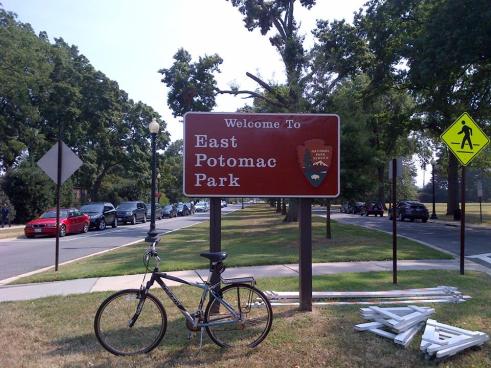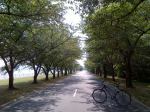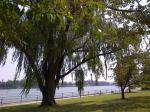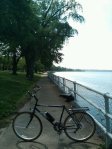On this day in 1939, the 32nd President, Franklin D. Roosevelt, laid the cornerstone of the memorial to our nation’s 3rd President, Thomas Jefferson. Construction of the memorial had begun the previous December, and would not be completed until 1943. The 19-foot tall bronze statue of Jefferson by the sculptor Rudulph Evans was subsequently added four years later, in 1947. Then, 75 years after the laying of the cornerstone, I rode to the memorial on this lunchtime bike.
As a public official, historian, philosopher, lawyer, businessman and plantation owner, Thomas Jefferson served his country for over five decades. In addition to being our country’s 3rd President, he was also one of America’s founding fathers, the principal author of the Declaration of Independence, Vice President of the United States, the first U.S. Secretary of State, member of the Continental Congress, a state legislator and Governor of Virginia, United States Minister to France, and the founder of the University of Virginia.
The Memorial to Thomas Jefferson is a neoclassical building which features circular marble steps, a portico, a circular colonnade of Ionic order columns, and a shallow dome. It is located in West Potomac Park, on the shore of the Potomac River Tidal Basin (MAP), and is enhanced with the massed planting of Japanese cherry trees, a gift from the people of Japan in 1912. Because many of the well-established cherry trees had to be removed for construction, there was significant opposition to its being built at that location. However, construction continued amid the opposition.
In addition to the domed building which is open to the elements and the prominent statue of Jefferson, the memorial prominently features quotes and exerpts from Jefferson’s writings. On the panel of the southwest interior wall are excerpts from the Declaration of Independence, which reads, “We hold these truths to be self-evident: that all men are created equal, that they are endowed by their Creator with certain inalienable rights, among these are life, liberty, and the pursuit of happiness, that to secure these rights governments are instituted among men. We…solemnly publish and declare, that these colonies are and of right ought to be free and independent states…And for the support of this declaration, with a firm reliance on the protection of divine providence, we mutually pledge our lives, our fortunes, and our sacred honor.”
On the northwest interior wall is an a panel with an excerpt from “A Bill for Establishing Religious Freedom, 1777”, except for the last sentence, which is taken from a letter of August 28, 1789, to James Madison. It reads, “Almighty God hath created the mind free…All attempts to influence it by temporal punishments or burthens…are a departure from the plan of the Holy Author of our religion…No man shall be compelled to frequent or support any religious worship or ministry or shall otherwise suffer on account of his religious opinions or belief, but all men shall be free to profess and by argument to maintain, their opinions in matters of religion. I know but one code of morality for men whether acting singly or collectively.”
The quotes from the panel of the northeast interior wall are from multiple sources, and reads, “God who gave us life gave us liberty. Can the liberties of a nation be secure when we have removed a conviction that these liberties are the gift of God? Indeed I tremble for my country when I reflect that God is just, that his justice cannot sleep forever. Commerce between master and slave is despotism. Nothing is more certainly written in the book of fate than these people are to be free. Establish the law for educating the common people. This it is the business of the state to effect and on a general plan.”
The inscription on the panel of the southeast interior wall is redacted and excerpted from a letter of July 12, 1816, to Samuel Kercheval. It reads, “I am not an advocate for frequent changes in laws and constitutions. But laws and institutions must go hand in hand with the progress of the human mind. As that becomes more developed, more enlightened, as new discoveries are made, new truths discovered and manners and opinions change, with the change of circumstances, institutions must advance also to keep pace with the times. We might as well require a man to wear still the coat which fitted him when a boy as civilized society to remain ever under the regimen of their barbarous ancestors.”
The monument is not as prominent in popular culture as other D.C. buildings and monuments, possibly due to its location well removed from the National Mall and its poor approximation to the Washington Metro subway system and accessibility to tourists. The Jefferson Memorial hosts many events and ceremonies each year, including memorial exercises, the National Easter Sunrise Service, and the annual National Cherry Blossom Festival.
On the American Institute of Architects list of America’s favorite architecture, it ranks fourth behind the Empire State Building, The White House, and Washington National Cathedral. The Jefferson Memorial is managed by the National Park Service under its National Mall and Memorial Parks division. The monument is open 24 hours a day but park rangers are there only until 11:30 p.m. However, the monument is only a few hundred yards from the National Park Police D.C. Headquarters in East Potomac Park.

















